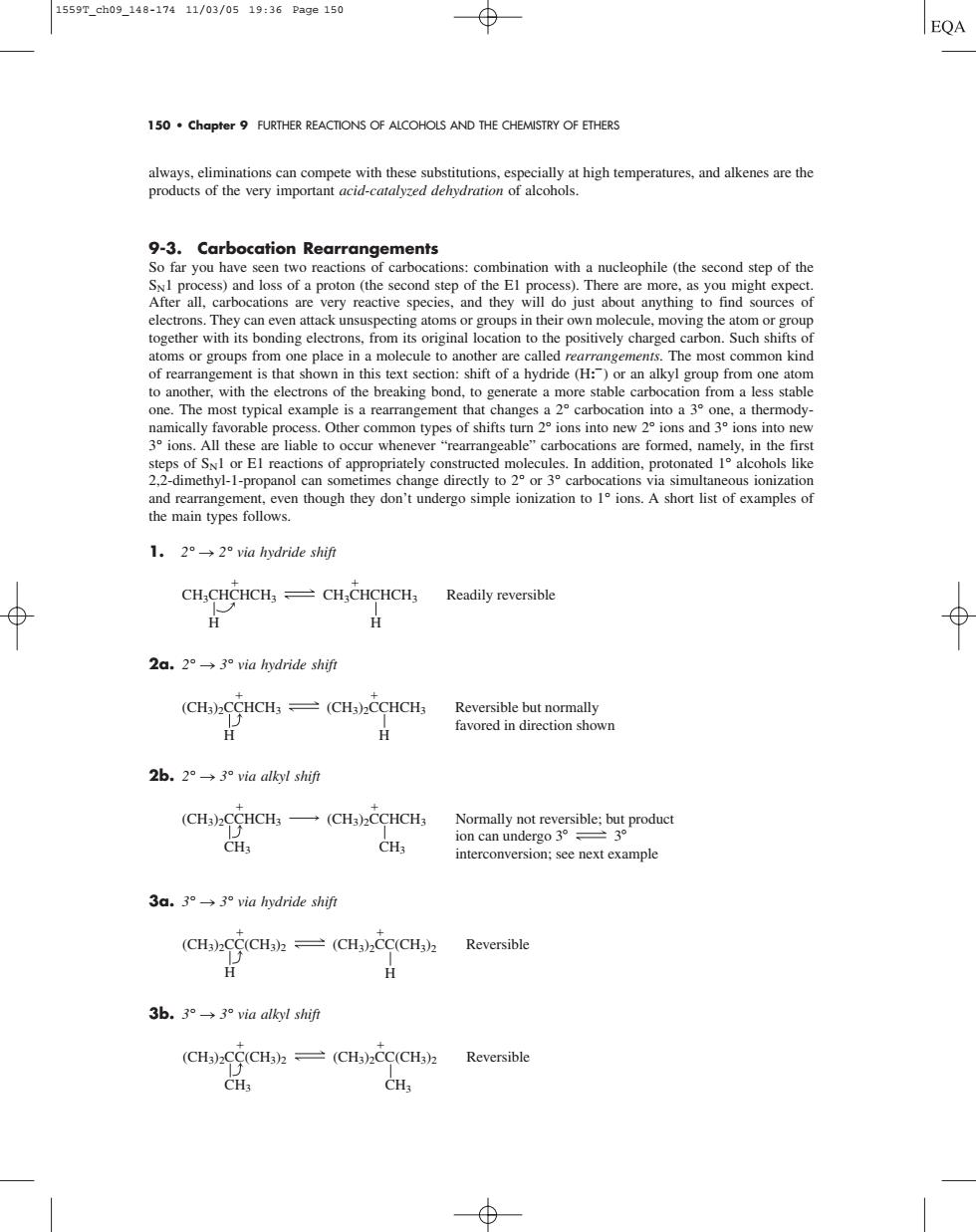正在加载图片...

1559Tch09148-17411/03/0519:36Page150 EQA 150.chapter9 FURTHER REACTIONS OF ALCOHOLS AND THE CHEMISTRY OF ETHERS 9-3.Carbocation Rearrangements o far you have en two reaction ation with a mucleophile (the step of th After a.carbocations are ery reactive specics.and they vill do just about anything to find sources o electrons.I can even att specting atom a roups in】 ir ow ecule,mov atoms or g ups from one place in a molecule to another are.The most common kind of rearrangement is that shown in this text section:shift of a hydride (H:)or an alkyl group from one a .Other common types of shifts tum 2 ions into new 2 ions and 3 ions into nev on e formed,r n the 1 mg6.cthouhthgdntundeompkomiaimoPioasAaliaofmptsoi 1.2°→2°via hydride shif CH,CHCHCH=CH,CHCHCH3 Readily reversible H 2a.2°→3°via hydride shif (CH3)CCHCH3 (CH3)CCHCH; 2b.2°→3 via alkyl shif (CH3)CCHCHs-(CHs)CCHCH3 interconversion:see next example 3a.3°→3°via hydride shi (CHa)2CC(CHa)2-(CH3)zCC(CHa)Reversible H 36b.3°→3°via alkyl shi0 (CH3)2CC(CH3)=(CH3)2CC(CH3)2 Reversible CH:150 • Chapter 9 FURTHER REACTIONS OF ALCOHOLS AND THE CHEMISTRY OF ETHERS always, eliminations can compete with these substitutions, especially at high temperatures, and alkenes are the products of the very important acid-catalyzed dehydration of alcohols. 9-3. Carbocation Rearrangements So far you have seen two reactions of carbocations: combination with a nucleophile (the second step of the SN1 process) and loss of a proton (the second step of the E1 process). There are more, as you might expect. After all, carbocations are very reactive species, and they will do just about anything to find sources of electrons. They can even attack unsuspecting atoms or groups in their own molecule, moving the atom or group together with its bonding electrons, from its original location to the positively charged carbon. Such shifts of atoms or groups from one place in a molecule to another are called rearrangements. The most common kind of rearrangement is that shown in this text section: shift of a hydride (H: ) or an alkyl group from one atom to another, with the electrons of the breaking bond, to generate a more stable carbocation from a less stable one. The most typical example is a rearrangement that changes a 2° carbocation into a 3° one, a thermodynamically favorable process. Other common types of shifts turn 2° ions into new 2° ions and 3° ions into new 3° ions. All these are liable to occur whenever “rearrangeable” carbocations are formed, namely, in the first steps of SN1 or E1 reactions of appropriately constructed molecules. In addition, protonated 1° alcohols like 2,2-dimethyl-1-propanol can sometimes change directly to 2° or 3° carbocations via simultaneous ionization and rearrangement, even though they don’t undergo simple ionization to 1° ions. A short list of examples of the main types follows. 1. 2° n 2° via hydride shift 2a. 2° n 3° via hydride shift 2b. 2° n 3° via alkyl shift 3a. 3° n 3° via hydride shift 3b. 3° n 3° via alkyl shift (CH3)2CC(CH3)2 CH3 (CH3)2CC(CH3)2 CH3 Reversible (CH3)2CC(CH3)2 H (CH3)2CC(CH3)2 H Reversible (CH3)2CCHCH3 CH3 (CH3)2CCHCH3 CH3 Normally not reversible; but product ion can undergo 3 3 interconversion; see next example (CH3)2CCHCH3 H (CH3)2CCHCH3 H Reversible but normally favored in direction shown CH3CHCHCH3 H CH3CHCHCH3 H Readily reversible 1559T_ch09_148-174 11/03/05 19:36 Page 150������������